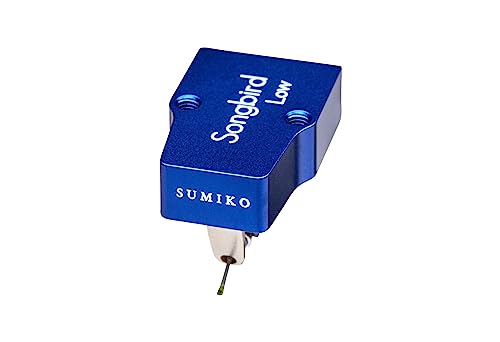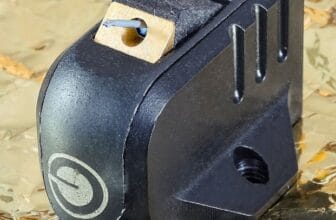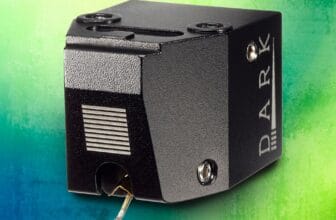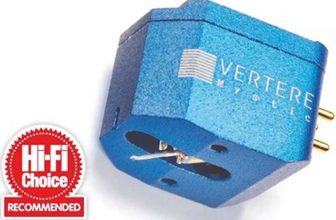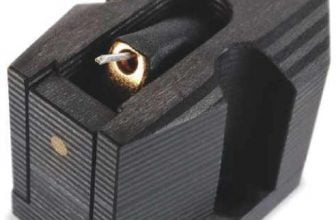Sumiko songbird review – Coil Quality
Sumiko’s Songbird offers moving coil quality – that’s the promise. Noel Keywood checks out an MC in MM clothing. Read our Sumiko songbird review.
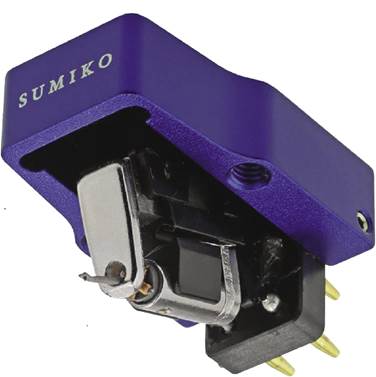
Songbird from Sumiko is a moving coil (MC) cartridge – suggesting top sound quality – that doesn’t need a special moving coil preamp. It will work into any standard phono stage, meaning of the moving magnet (MM) variety. So the proposition is you get the spacious sound of a moving coil without forking out for a special preamp. Above most MMs that top out around £ and into true MC territory, albeit the lower rungs. But of course no MC preamp cost.
Before getting into Songbird details, a few quick points about the nature of the beast. High output MCs like the Songbird are not uncommon, but they come with their own set of compromises and drawbacks. Being a proper MC there’s no user-removable stylus assembly: if you bend it you’ll have to replace it. Ask the dealer about the replacement scheme; they vary between manufacturers and change over time.
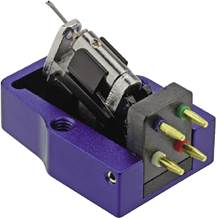
The Songbird’s rear connecting pins have a long taper, that you can see here. This gives very little full-diameter contact area.
obviously worked on these points.
Now for Songbird details. It has an attractive blue anodised alloy body and a bright parts around the magnet system / pole pieces. As our pictures show, the aluminium alloy cantilever protrudes to make the stylus tip clearly visible and this
MC, which is a technical issue. But Sumiko, a U.S. company that gets its cartridges manufactured in Japan, have
The other drawback is they don’t track well and, in my experience, don’t sound much like an
aids alignment above groove – great if you have a cueing light. I found I could hit a run-in groove easily.
“deathly silence: no hiss, no hum, nothing”
Note though this is a parallel sided alloy tube, not a stiffer and less resonant tapered alloy tube that I prefer in sound quality to most else (especially clanky beryllium rods). More on this later.
With a nice, stiff alloy body weighing 8.5gm, carrying threaded M2.5 open-ended screw holes (at trad. half-inch fixing centres) the Songbird suits all arms and is both easy and quick to bolt in. Yet this bit of the installation process threw up a bizarre issue I have never come across since first installing cartridges in – er, well – I don’t know, but a good 50 years (Shure M3D on…). When I pushed the SME cartridge connector leads onto the Songbird’s pins they popped off immediately. Uh?
After many attempts I peered at the pins closely and saw a long taper on them, leaving very little full
diameter contact area. Because our SME female floating
connectors have a flare
to accept the male pin there’s no contact space left to form a firm
connection. Bizarre!
The taper is, I suspect, to make connection easier but it is simply too long – an inept piece of design. I crimped our SME gold plated pins to get a grip but I believe this weird design failure will cause unexpected difficulty to new owners (and/or dealers!).
Tracking force is a sensible and now-normal range of 1.8-2.2gms, with 2gm recommended – and that is what I used. The coils have 135 Ohm impedance, far lower than a typical MM (1000 Ohm), the significance of this being the Songbird produces no audible (Johnson) noise. Turning up volume, all I heard was deathly silence: no hiss, no hum, nothing.
The cantilever is a ‘coated aluminium pipe’ (no mention of the coating) fitted with a 0.3 x 0.7 micron elliptical stylus.
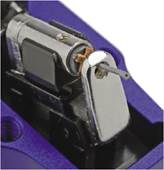
It’s a moving coil and here you can see the miniature coils at the end of the cantilever.
At the price packaging was basic: a simple wooden case, no instruction sheet and just two short hex-head fixing screws with hex key in a plastic bag. Not brass either, but possibly stainless steel. It was all a bit basic compared to the screw set and accessories that come from Ortofon and Audio Technica, both of whom lead the field.
SOUND QUALITY
I used the Songbird in our SME309 arm, fitted to a Timestep Evo modified Technics SL-I 210 Mk2 Direct Drive turntable. It fed an Icon Audio PS3 MkII valve phono stage, driving a Creek Evolution 100A amplifier hooked up to Martin Logan ESL-X hybrid electrostatic loudspeakers through Chord Company Signature Reference cables.
With Hugh Masekela’s ‘Uptownship’ from his Hope LP (180gm, all-analogue) what I heard was a svelte delivery, smooth and balanced; no hissing treble or obvious incision. There was plenty of weight and timbrality to trumpet, it’s rich tone obvious. The underpinning bass line was well extracted, fluid and strong. But my listening notes call it a “safe” delivery, not overly challenging.
With Mark Knopfler’s True Love Will Never Die, from his Kill to Get Crimson LP (180gm) there was a lack of bite or sparkle to guitar, but vocals had weight and good dynamic push. Knopfler sounded big and clear in front of me, and again I noticed a bass line with great fluidity and agreeable strength.
Bass performance again made itself known with Jackie Leven’s Stornoway Girl, where bass plays lead and the Songbird picked it out with superb resolution. This was an inner groove track on Forbidden Songs of the Dying West, quite a high cut, yet the Songbird had no difficulty tracking it. Same also with Rosella Caporale’s Time to Say Goodbye, another inner groove track, on Two Countries One Heart (I80gm, all analogue), where her final vocal crescendo was tracked with easy confidence.
The sense of easy, relaxed treble became more questionable with Fleetwood Mac’s Second Hand News from our all-analogue remaster where I became more aware that, up-top, the Songbird was a little bland. Great bass line and solid vocals but not so much high-end detail. Swapping over to our Audio Technica VM750SH MM with its tapered alloy cantilever and Shibata stylus made clear that the groove had a lot more in it than the Songbird was revealing.
CONCLUSION
Sumiko’s Songbird has some great sonic strengths: think fine bass, solid and expressive, excellent mid-band vocals with body and dynamic punch. But its easy and unchallenging top end made for vague treble insight.
I enjoyed its strengths and if you have an old and noisy collection of LPs from your misspent youth this may well be a fine choice. No special amp needed but you get some of the delights of a moving coil cartridge, namely deep sound staging and strong dynamics. It is expensive though and there are swathes of alternatives with more insightful delivery, moving magnet and moving coil. So “horses for courses” perhaps. Svelte and enjoyable, not rudely revealing, an easy listen.
MEASURED PERFORMANCE
Frequency response of the Songbird measured impressively flat out to 20kHz, as our analysis shows (JVC TRS-1007 test disc). This will give it a smooth and tonally balanced sound. Inner groove loss (red trace) due to tip radius is minimal up to 15kHz, falling to -4dB at 20kHz – a very good result.
Tracking of 300Hz test tones on CBS-STR112 test disc was very good, Songbird managing a high 90muy m lateral track at 2gm down force, if with slight mistracking – hence our 80pm figure.
Tracking at 1kHz (B&K2010 test disc) where acceleration is higher and tip mass more influential, a high 20cms/sec band was cleared, but not the top 25cms/ sec band. Still a good result however, especially for a high output MC where this track usually causes problems.
Distortion was as expected and hoped for, measuring 1.2% on lateral modulation (CBS-STR112). On vertical modulation the figure was a reasonable 3.3% due to a measured vertical tracking angle of 24 degrees (DIN 45-452 test disc). Optimal is 22 degrees, so Songbird got very close.
Output measured 2.2mV at 3.45cm/ sec, low by MM standards but high for a moving coil. A good result, especially as the 135 Ohm coil produces almost no Johnson noise, giving the cartridge high dynamic range.
The Songbird is accurate tonally and tracks very well. A fine set of results with no weaknesses. NK
Tracking force 1.8-2.2gm
Weight 8.5gms
Vertical tracking angle 24degrees
Frequency response 25Hz-20kHz
Channel separation 26dB
Tracking ability (300Hz) lateral 80pm
vertical 45pm
lateral (1kHz) 20cms/sec.
Distortion (45pm) lateral 1.2%
vertical 4.2%
Output (3.45cms/sec rms) 2.2mV
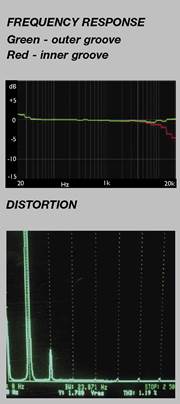
EXCELLENT – extremely capable.
VERDICT
When you purchase through links on our site, I may earn an affiliate commission. Here’s how it works.
Read our MOVING-COIL CARTRIDGES GROUP TEST
Henley Audio +44 (0)1235 511166 www.henleyaudio.co.uk
